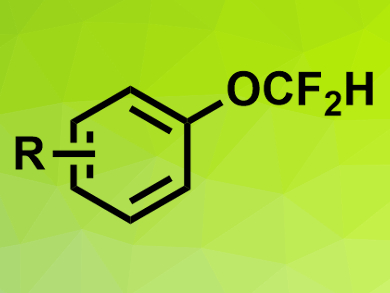Fluorine-containing groups are useful to tune the properties of biologically active compounds. Difluoromethoxy (OCF2H) groups, for example, are common in medicinal chemistry. However, this group usually needs to be installed early in the synthesis of drug candidates due to the required harsh reaction conditions.
Peng Liu, University of Pittsburgh, PA, USA, Ming-Yu Ngai, Stony Brook University, NY, USA, and colleagues have developed a protocol for the late-stage direct difluoromethoxylation of unactivated arenes and heteroarenes. The method uses a redox-active difluoromethoxylating reagent under photocatalytic conditions and proceeds via a radical mechanism.
The team used a benzotriazole-based OCF2H reagent (1-(difluoromethoxy)-3-methyl-6-nitro-4-(trifluoromethyl)-1H-benzo[d][1,2,3]triazol-3-ium trifluoromethanesulfonate), together with Ru(bpy)3(PF6)2 (bpy = 2,2′-bipyridine) as a photocatalyst in acetonitrile under blue LED irradiation at room temperature. The researchers were able to convert a range of unactivated arenes and heteroarenes to the desired difluoromethoxy derivatives (pictured). The reaction gives multiple regioisomers, which could be useful for drug screening.
- Catalytic radical difluoromethoxylation of arenes and heteroarenes,
Johnny W. Lee, Weijia Zheng, Cristian A. Morales-Rivera, Peng Liu, Ming-Yu Ngai,
Chem. Sci. 2019.
https://doi.org/10.1039/c8sc05390a




